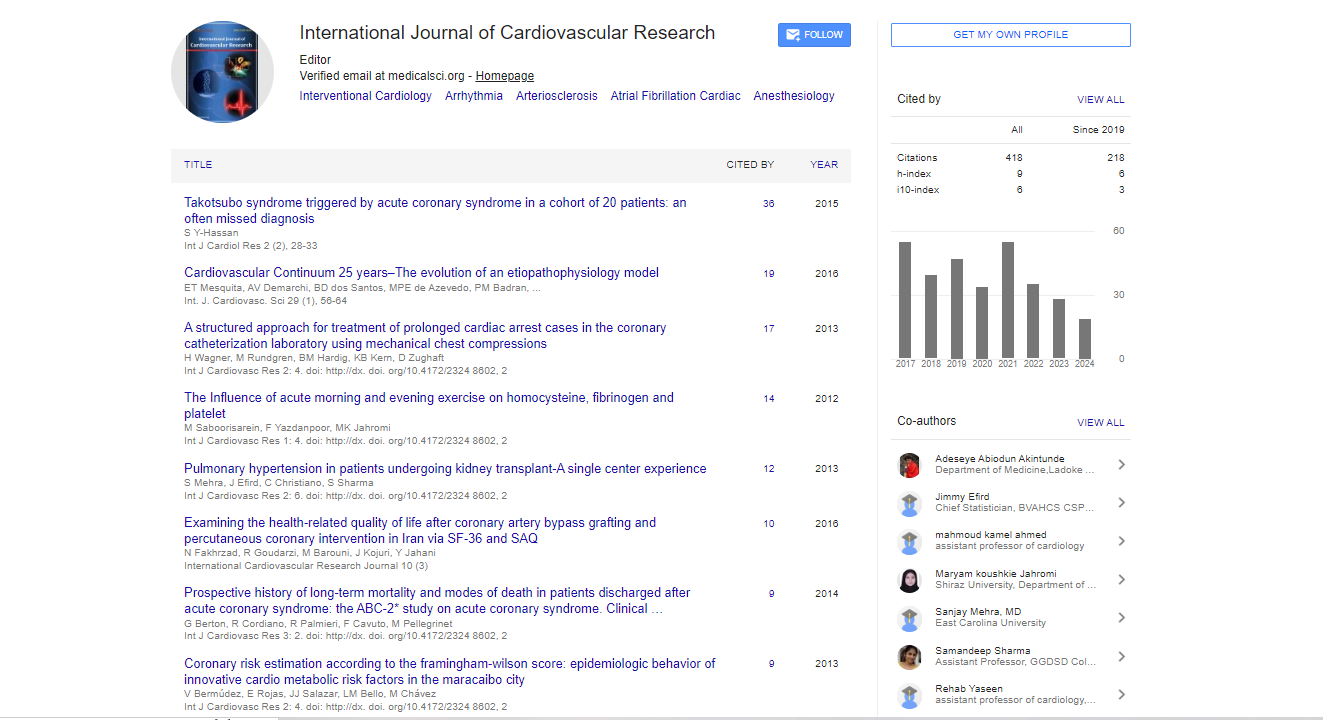Perspective, Int J Cardiol Res Vol: 12 Issue: 5
Effects of Lifestyle Changes on Angina Prevention and Management
Seraphine Carrington*
1Department of Medicine, University of Miami Miller School of Medicine, Miami, Florida
*Corresponding Author: Seraphine Carrington,
Department of Medicine,
University of Miami Miller School of Medicine, Miami, Florida
E-mail: seraphine.carrington@gmail.com
Received date: 25 September, 2023, Manuscript No. ICRJ-23-119411;
Editor assigned date: 28 September, 2023, PreQC No. ICRJ-23-119411 (PQ);
Reviewed date: 11 October, 2023, QC No. ICRJ-23-119411;
Revised date: 19 October, 2023, Manuscript No. ICRJ-23-119411 (R);
Published date: 27 October, 2023, DOI: 10.4172/2324-8602.1000523
Citation: Carrington S (2023) Effects of Lifestyle Changes on Angina Prevention and Management. Int J Cardiol Res 12:5.
Description
Angina, a common symptom of coronary artery disease, occurs when the heart muscle doesn't receive enough oxygen-rich blood. This deficiency can lead to chest pain, discomfort, and a sense of pressure. While medications and medical procedures are essential components of angina management, lifestyle changes play a pivotal role in both preventing and effectively managing angina.
Understanding angina
Angina occurs when there is an imbalance between the heart's oxygen demand and its oxygen supply. This imbalance typically results from the narrowing or blockage of coronary arteries, reducing the flow of blood to the heart muscle. When the heart works harder, such as during physical activity or stress, it requires more oxygen. In angina, the heart struggles to meet this demand, causing chest pain or discomfort. Unmanaged angina can lead to more severe conditions, including heart attacks.
Lifestyle changes for angina prevention
A heart-healthy diet is foundational for angina prevention. It involves, limiting the intake of these fats, found in fried foods and certain processed snacks, helps lower Low-Density Lipoprotein ("bad") cholesterol levels, reducing the risk of arterial plaque buildup. Consuming fiber-rich foods like fruits, vegetables, and whole grains can help manage cholesterol levels and improve heart health. Reducing sodium intake can help control blood pressure, which is essential in angina prevention. Overeating can lead to obesity, a risk factor for coronary artery disease. Controlling portion sizes is a key component of a heart-healthy diet.
Regular physical activity strengthens the heart, lowers blood pressure, and improves overall cardiovascular health. An exercise routine can help prevent angina by, Exercise promotes efficient blood flow, reducing the workload on the heart and minimizing the risk of angina. Maintaining a healthy weight lowers the risk of coronary artery disease. Regular exercise can lead to beneficial changes in heart structure and function.
Smoking is a major risk factor for angina and coronary artery disease. Quitting smoking significantly reduces the risk of angina and other heart-related conditions.
Chronic stress can increase the risk of angina by elevating blood pressure and causing inflammation. Stress management techniques, such as meditation, yoga, and deep breathing exercises, can help lower stress levels and improve heart health.
Excessive alcohol consumption can contribute to high blood pressure and heart problems. Moderation or abstinence is recommended to prevent angina.
Lifestyle changes for angina management
If diagnosed with angina, medication prescribed by a healthcare provider is vital. Patients must adhere to their medication regimen, as these drugs help control symptoms, prevent complications, and improve overall heart health.
Exercise remains important even after an angina diagnosis. Cardiac rehabilitation programs provide a safe and supervised environment for individuals to engage in structured exercise routines that strengthen the heart and increase exercise tolerance.
Patients may benefit from a modified diet that includes foods with anti-inflammatory properties, like omega-3 fatty acids found in fatty fish. Additionally, consulting with a dietitian can help individuals build a heart-healthy meal plan tailored to their specific needs.
Maintaining a healthy weight is essential for managing angina. Weight loss, if necessary, can help improve blood pressure, cholesterol levels, and overall heart health.
Identifying and reducing factors that trigger angina, such as extreme temperatures, heavy meals, or emotional stress, is essential in angina management.
Conclusion
Lifestyle changes are paramount in both the prevention and management of angina. A heart-healthy diet, regular physical activity, stress management, and other key adjustments can help reduce the risk of angina and improve overall cardiovascular health. For those diagnosed with angina, lifestyle changes remain an important component of treatment, along with medication and medical procedures.
Taking control of one's heart health through lifestyle changes not only reduces the risk of angina but also enhances overall well-being. By adopting a proactive approach to angina prevention and management, individuals can live healthier, more fulfilling lives, and reduce the burden of this common heart condition. Regular consultations with healthcare providers and personalized advice from specialists are invaluable in developing effective and sustainable lifestyle changes for angina prevention and management.
 Spanish
Spanish  Chinese
Chinese  Russian
Russian  German
German  French
French  Japanese
Japanese  Portuguese
Portuguese  Hindi
Hindi 



